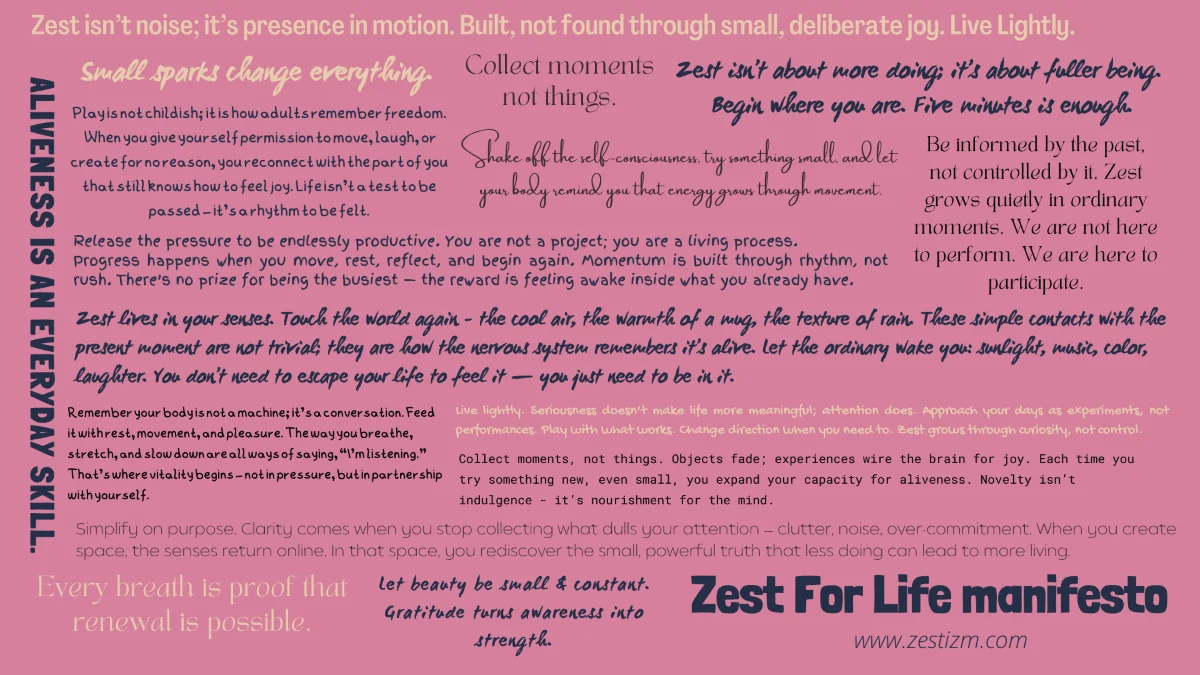Zest for Life: A Practical Guide to Everyday Aliveness
Zest isn’t hype or relentless optimism, it’s presence. It is learning to notice again, to act before you feel ready, and to build momentum that feels human. This guide helps you reclaim that sense of aliveness through small sparks, daily reflection, and mindful attention.
“Zest isn’t something you wait for — it’s something you train.” – The Zest Sparks Guide
What is “Zest for Life”?
Living with zest means engaging your senses and emotions so life feels vivid again rather than rushed or distant. It is the art of participation over performance. Through small sparks and reflection, you learn to convert movement into meaning.
- Notice: Awareness is the ignition point.
- Do: Small, deliberate actions build energy.
- Feel: Emotion follows movement.
- Reflect: Learning turns effort into growth.
Six Steps to Reignite Your Zest for Life
How to Notice What Sparks You
Awareness is ignition. Learn how to recognise the small signals that lift your mood and focus.
Read more →Zest vs Momentum: Turning Routine into Aliveness
Movement keeps you going; zest reminds you why it matters. Learn how they work together.
Read more →The Daily Practice of Zest
Five-minute micro-practices that return presence, energy, and mood stability.
Read more →Design for Aliveness
Shape your space and schedule so energy flows instead of leaks. Your environment is your quiet coach.
Read more →How to Reignite Joy When Life Feels Flat
Micro-joys and novelty reset your brain’s reward system. Discover how to feel light again.
Read more →Reflection: Keeping Your Spark Alive
Reflection completes the learning loop — it’s how zest becomes habit, not hype.
Read more →
Quick Answers to Common Zest Questions
What does “zest for life” really mean?
It’s the habit of engaging fully with the present moment — using your senses and curiosity to feel alive again. Read more about zest →
Why do I feel like I’ve lost my spark?
Stress and sameness dull your nervous system. The cure isn’t more effort — it’s gentle novelty and attention. Try these ideas →
How can I rebuild zest after burnout?
Zest returns through repetition, not extremes. One mindful action a day can reawaken your energy. Start small →
Is zest the same as happiness?
No. Happiness depends on outcomes; zest depends on participation. You can feel zest even in challenge. Read more →
What’s one thing I can do right now?
Notice one pleasant detail — light, sound, colour — and breathe it in. Zest begins in that moment of awareness. First step →
Free Sample - Start Your First Spark Today
Download the opening chapter of The Zest Sparks Mini Guide - “What Zest Really Means.” Inside you will discover why aliveness isn’t about constant happiness, how state change works in NLP, and one practical exercise to anchor your own spark. Five minutes of reading can shift your energy today.

Featured Articles on Living With Zest
Zest vs Happiness: Why Aliveness Matters More Than Positivity
Understand the difference between outcome joy and everyday engagement.
Zest vs Motivation: How to Act First and Feel Later
Why motivation follows action, not the other way around.
The Science of Small Joys: Micro Moments That Rewire Mood
Evidence-backed joy practices to keep your energy up.

FAQ
What causes people to lose their zest for life?
Prolonged stress and sameness dull your senses. Over time, your brain reduces novelty and curiosity to conserve energy. Zest returns when you add movement, micro-joy, and gentle presence back into your day.
Can I regain zest after burnout?
Yes. Zest rebuilds through consistency, not intensity. Start small — one spark, one walk, one breath — and repeat daily. Energy follows attention, not force.
What’s the connection between zest and emotional resilience?
Zest strengthens resilience by re-engaging the senses. It keeps the nervous system flexible, so challenges feel recoverable instead of overwhelming.
How long does it take to feel alive again?
Most people notice small shifts within a week of daily sparks. Presence builds gradually — a quiet warmth that spreads through repetition.
Reflection
Today, don’t chase a better mood. Chase a moment of aliveness — one spark that reconnects you to your own rhythm.